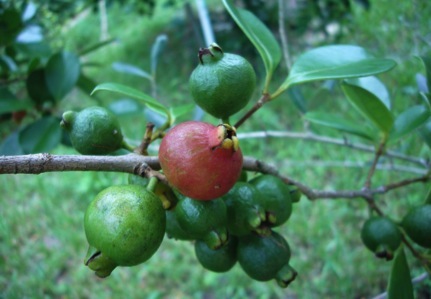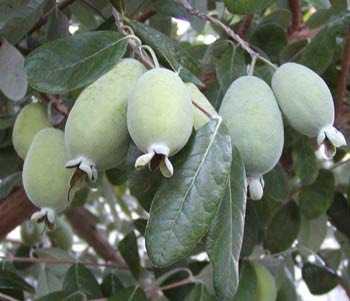Psidium littorale var. cattleianum: Strawberry Guava
One man’s fruit tree is another man’s weed. My one Strawberry Guava tree is a fruiting delight. However, in the Caribbean, Hawaii, and parts of Florida, it’s an invasive weed, which also means free food. Then again, when you think of it, foragers are always surrounded by food.
Native to the Atlantic coast of Brazil, the Strawberry Guava has been exported to warm places around the world and naturalized. Where you find citrus you will find Strawberry Guava. It was imported into Florida in the 1880s as an ornamental and for fruit production. Closely related to the common guava, it forms dense stands that overpowers local species. Once entrenched it is hard to remove. Currently there are no controls though Hawaii is in the process of importing an insect to slow its growth. All the while it produces fruit.
That it is a guava is not debatable. That its fruit tastes like strawberries is. When the fruit is extremely ripe it can have a momentary fragrance of strawberry. Otherwise to me it tastes more like tart passionfruit.
I have learned that picking the fruit requires timing. The fruit starts out hard and green. At some point they begin to ripen and become mottled, a little, green, a little white, a little red. As a fruit turns color it also softens. At that stage it is perfect for picking. It will be tart, seeds not quite hard yet, and bug free. If you wait until the fruit turns completely red, or even dark red, it will — here at least — be full of fruit fly larvae. That is not to say, however, that the fruit is unusable then. That depends on whether you like the extra protein.
The fruit of the Strawberry Guava can be eaten right off the bush. The seeds are hard so chew strategically. The skin is tart and some folks prefer to scoop out the sweet flesh and seeds not eating the skin. Some prefer just the flesh, which is sweet. The seeds can be eaten carefully or roasted as a coffee substitute. Thus older, wormy fruit can be collected for their seeds. The leaves of the tree can also be used to make a tea. I’ve made the fruit into jelly and fruit leather. You might want to omit the seeds from the fruit leather. They stay hard and challenge your dentistry, but they can be included if you want. The wood is good for smoking meat and can also be made into tools and toys.
The Strawberry Guava is an all-round versatile weed. Perhaps the only draw back, besides being invasive, is it fruits only once a year and all at once, over and done with within a couple of weeks. I have found if I pick the ripening fruit daily it ripens more fruit and lessens the fruit fly issue.
Botanically, the Strawberry Guava is in the myrtle family and is Psidium littorale var cattleianum. SID-ee-um lit-aw-RAY-lee catt-tee-eye-AY-num. Psidium is the Greek word for pomegranate. Littorale is of the sea shore. The variety is named after William Cattley (d. 1832), English horticulturalist who was the first person to successfully cultivate the species. The Strawberry Guava is also called Psidium cattleianum. Incidentally, there is a Pineapple Guava as well, Feijoa sellowiana. I’ve only seen one. It’s fruit stays green and has an odd cross shape on the end. It drops when ripe but can be picked before that. See picture above. Its blossom petals are edible.
Green Deane’s “Itemized” Plant Profile
IDENTIFICATION: Evergreen shrub or small tree to 25 feet tall, with gray to reddish-brown peeling bark and young branches round, slightly hairy. Leaves opposite, simple, no teeth, no hair, elliptic to oblong to 3 inches long. Flowers: To just over an inch wide; single at leaf axils, with white petals and a mass of white and yellow stamens. Fruit golfball size, looks similar to small pomegranates, purple red, whitish flesh, sweet when ripe, many seeds. There is also a yellow edible version.
TIME OF YEAR: Can bloom and fruit all year but bears its main crop in early to mid summer.
ENVIRONMENT: Extreme. It can grow in near dry conditions to a rainforest. The more water and sun, the taller it can grow. Will not tolerate freezing.
METHOD OF PREPARATION: Many. It can be eaten off the bush, best when between green and red, mottled. Can be made in to pies, jam, jellies, drinks, sauces, fruit leather et cetera. Seeds are edible but hard. Can be roasted and used to extend coffee or as a substitute. A tea can be made from the leaves. A yellow species can be used the same way. Again, the seeds while edible are tough and hard on your teeth.



